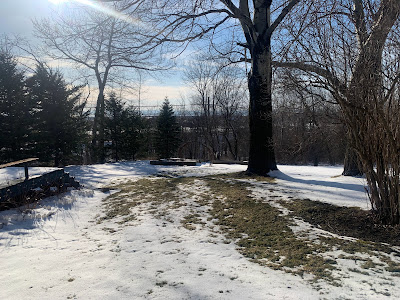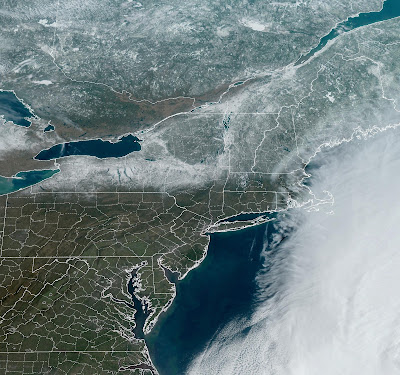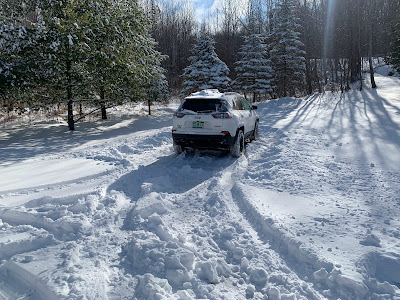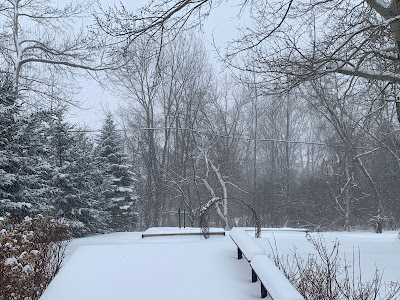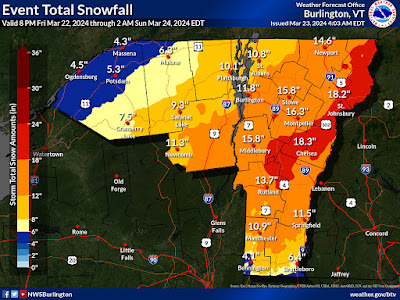This should we an interesting weather week for the nation as a whole and here in Vermont.
The storm has already set off heavy snow in some of the mountains of the West, and even a few severe thunderstorms for parts of California.
The developing storm is threatening to set off more wildfires in New Mexico, western Texas, parts of Colorado and western Oklahoma as the system sends dry, warm winds through the region.
A large severe weather outbreak will start today to an extent in Missouri and Illinois. Then the threat grows larger Monday and Tuesday through a much more expansive area in the Midwest and Southeast.
Flooding is also a threat in parts of the south and east. Some areas will get heavy snow out of this, which is where Vermont and other parts of the Northeast come in.
VERMONT STORM
The storm in question looks like it will be pretty large, powerful and slow moving, so it'll have a chance to give quite a bit of weather to the Northeast.
Some areas, especially the higher elevations could get a ton of new snow out of this, but the devil of course is always in the details.
The easy part will be to go through the calm before the storm, so we'll do that first
Today
Not bad for an early Easter! Clouds from a weak overnight disturbance were clearing out this morning and we should have a largely sunny, seasonable day. Expect highs in the 40s, with a few warmer valleys touching 50 degrees
Monday
An initial disturbance, the opening salvo of this big storm, is the piece producing the potential severe weather in Missouri today. It'll pass by to our south tomorrow, sending some clouds our way. It'll be cloudiest south with even a chance of a light shower. There should be at least some sun north. Another seasonable day with 40s to around 50, warmest north.
Tuesday
Here it comes. Starting here, the forecast is subject to HUGE changes. A storm this big and complex is sure to provide quite a few surprises.
It does seem as if this storm will be bigger and more powerful than your average early April system. We don't know yet who gets the most rain, the most snow, and precisely how long it will last.
We'll give the broad brush here, and I note future posts in this here blog thingy will highlight changes to the forecast I lay out there. This initial crack at the forecast is just to give you a general idea of what will happen.
 |
| My perennial gardens in St. Albans, Vermont showing signs of springtime life this Easter Sunday morning, but these plants could well be buried in snow by midweek. |
In the end, I think virtually everyone in Vermont will see some snow. Some of us will only get a little. Some of us could really get clobbered,
Anyway, clouds thicken and lower Tuesday and rain will break out. The storm will end up somewhere near Lake Erie overnight Tuesday. At that point, the early read on this is valleys in Vermont will be getting rain, while it will already be snowing in the mountains.
Then it gets even more interesting.....
Wednesday
The main storm center near Lake Erie will begin to fade out as a new storm gets going on the Mid-Atlantic coast and moves northward, becoming a strong nor'easter centered near southeastern New England by Wednesday night.
This arrangement feeds plenty of moisture inland through New England and also allows temperatures to cool well away from the coast. That's us.
This would allow at least a mix of rain and snow in the valleys and probably all snow up high. Depending on the path of the storm, I already see a potential for over a foot in some high elevations of Vermont. If that happens, I don't know where yet. It depends on whether the storm is a little inland or a little off the coast.
Inland would give most of Vermont a lot of snow. Offshore would favor mostly southern parts of the state.
Thursday
The storm seems like it might want to pretty much stall somewhere near eastern New England or just offshore Thursday. If that happens, the storm for Vermont would turn into one of those wrap-around storms.
That could bring a lot of snow to the western slopes and summits of the Greens, but not much additional snow to southeastern Vermont. We'll see how it plays out.
Friday-Weekend
The storm as it stands now would slowly drift eastward and weaken somewhat, so snow and maybe valley rains would slowly diminish. Timing of this is a big question mark. Will the precipitation end fairly quickly, or linger through the weekend?
Eclipse Day Monday
The storm should be out of our hair by then, which is great news. But it's still way too soon if it will actually be clear out so we can actually see this once in a lifetime event.
Long range forecasts - at least at the ,moment - do not have any large scale storms near Vermont at the time the eclipse rolls around. But it only takes a weak weather disturbance to make our skies overcast. It's way too soon as of this Easter morning to know if anything will cloud our skies on eclipse day.
Keep praying to the weather gods for a clear April 8!













